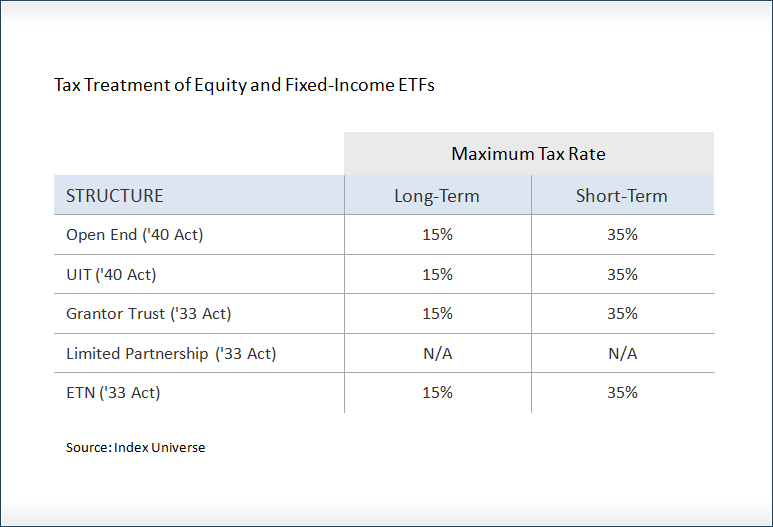ETF Tax Forms and TaxFree Alternatives
Post on: 30 Март, 2015 No Comment

April is here, which means warmer weather for most of us. Unfortunately, it also brings income tax time.
This year you get an extra day to procrastinate since April 15 falls on Sunday. A small consolation, but I’ll take it.
As an ETF investor you have some advantages in the tax department, but you aren’t completely off the hook.
Today I’ll give you some links to helpful information, update you on a type of tax-friendly ETF, and shed some light on those mysterious “K-1″ forms you may be dreading.
Stay Informed
April 15 is almost here!
Let’s start with some references that may come in handy as you gather your paperwork:
- This time last year I gave you a rundown on Your ETFs and the Tax Man .
- In December I explained how to Put Cash in Your Wallet with ETF Tax-Loss Harvesting! If you took advantage of this strategy, you may be paying less this month. If not, read the column again and maybe you can try it for 2012.
In most cases, your brokerage firm will tell you about taxable gains (or losses) and dividend payments in your ETFs on a form 1099. If you have a professional prepare your return (always a good idea), just hand over the information your broker sends. The preparer should be able to take it from there.
If you do it on your own, remember that the numbers on your 1099 aren’t treated any differently because they come from ETFs. If you’re used to reporting income from stocks or mutual funds, you’ll find the ETF process pretty familiar — and possibly easier.
What Is This “K-1″ Business?
Some ETFs and ETNs have to send you a different form called “Schedule K-1.” This is particularly the case for products based on futures contracts, commodities, currencies, or other alternative strategies.
Schedule K-1 makes some folks mad.
I’ve talked to investors who regard “K-1″ almost like a form of profanity. Something about them just makes people angry. I’m no fan, either, but they’re part of the landscape.
I try to look at the bright side. The same ETFs and ETNs that generate K-1 paperwork give me the chance to invest in ways that were once all but impossible. If I have a chance, at least, to make money in these strategies, I’ll deal with the hassle.
Muni Bonds: What’s the Appeal?
If you find yourself paying too much investment related taxes, then you may want to consider a municipal bond ETF. In January 2011, I told you about Two Muni ETFs to Avoid — and One That’s Surprisingly Safe!

Municipal bonds are issued by state and local governments. A big part of their appeal is that the interest they pay isn’t subject to federal income tax.
Now “tax-free” isn’t necessarily better. They tend to have lower yields than taxable bonds of similar quality. If you are in a low tax bracket, you may be better off going for a higher yield and paying tax on it.
In the Money and Markets column linked above, I was skeptical of PowerShares Insured National Muni Bond (PZA). I went so far as to call it “fool’s gold.” My main concern: The “insured” aspect was (and still is) dependent on some shaky bond insurance companies.
That’s still a concern. However, PZA has sailed right through a pretty scary period for the muni bond market. And the weakest bond insurers are now out of the picture. PZA may be worth another look.
Advertisement
If tax-free income is one of your investment goals, here are some other leading municipal bond ETFs to consider:
- iShares S&P National Municipal Bond (MUB) is the largest ETF in this group. It’s very liquid and holds a diversified portfolio.
- SPDR Barclays Municipal Bond (TFI) covers mostly the same ground as MUB and is a worthy alternative.
- SPDR Barclays Short Term Municipal Bond (SHM) is the second-largest muni ETF. SHM has shown results similar to the Market Vectors Pre-Refunded Municipal ETF (PRB) that I mentioned in the same article with PZA.
Again, before you buy any kind of municipal bond fund, remember the tax benefit is valuable only to the extent you would otherwise pay taxes on that income. If your tax burden is minimal for other reasons, then a muni ETF can actually work against your bottom line.
Likewise, owning a muni ETF within an IRA or other retirement account is usually pointless. Why? Because you’re getting preferable tax treatment anyway!
ETFs can’t eliminate all your tax hassles, but they can definitely help. Remember to consult a professional any time you aren’t sure what the IRS wants. That’s what I always do.
Best wishes,
Ron
P.S. I track markets all around the world for my International ETF Trader members. In fact, I’m getting ready to release a reco for an ETF in a country that has been ignored by most investors … but not for long! To learn how to jump onboard before I send it out — and have our money-back, no-questions-asked guarantee — turn up your speakers and click here.
Ron Rowland is widely regarded as a leading ETF and mutual fund advisor. You may have read about Mr. Rowland and his strategies in publications such as The Wall Street Journal. The New York Times. Investor’s Business Daily. Forbes.com. Barron’s. Hulbert Financial Digest and many more. As a former mutual fund manager from 2000 to 2002, Ron was a pioneer in using ETFs inside of mutual funds. Today, he is the editor of International ETF Trader . dedicated to helping investors use ETFs to profit from ever-changing global market conditions.














